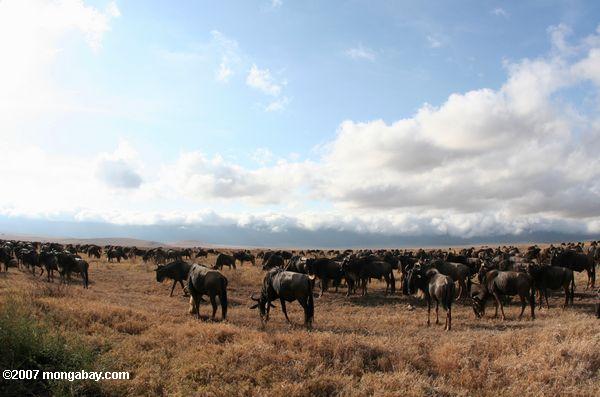A new study finds that a proposed road cutting through Serengeti National Park would likely have devastating consequences for one of the world’s last great migrations. According to the study the road itself could lead to a 35% loss in the famed park’s migrating wildebeest herd, essentially cutting the herd down by over half a million animals. Despite such concerns, and the availability of an alternative route that would bypass the Serengeti plains altogether, the Tanzanian government has stated it is going ahead with the controversial road.
“This project has the potential to transform one of the greatest wonders in the world and one of the world’s most iconic national parks,” said John Fryxell, an integrative biology professor at the University of Guelph and author on the study, in a press release.
The study, published in the open-access journal PLoS ONE, looked solely at the direct consequence of the road, i.e. fragmenting the wildebeest’s habitat. While the authors state that the road itself may not stop the migration, “there are reasons to believe, however, that as road traffic increases, fences and development might follow, eventually rendering a simple road project into a de facto barrier.”
The outcome may even be worse than the study predicts, as it does consider other possible impacts on the herd, including vehicle collisions with the animals, increased illegal hunting, and more development within the park. But the road won’t just impact the wildebeest.
“The wildebeest migration plays an important role in a number of key ecological processes, so this finding has important ramifications for ecosystem biodiversity, structure and function,” Fryxell said. For example, with less prey available big cat populations, already on the decline, are likely to suffer.
Recently it has been reported that the World Bank has proposed to help fund the alternative route to save the park from being cut. Yet the President of Tanzania, Jakaya Kikwete, insists the original plan for the road will go ahead.

Wildebeest herd in Tanzania. Photo by: Rhett A. Butler.
Related articles
World Bank offers to save Serengeti from bisecting road
(01/31/2011) The World Bank has offered to help fund an alternative route for a planned road project that would otherwise cut through Tanzania’s world famous Serengeti National Park, according to the German-based NGO Nature and Biodiversity Conservation Union (NABU). When announced last year, the road project raised protests from environmentalists, scientists, and Tanzanian tour companies, but the Tanzanian government refused to shift plans to an alternative southern route for the road, thereby bypassing the park.
Africa’s vanishing wild: mammal populations cut in half

(01/27/2011) The big mammals for which Africa is so famous are vanishing in staggering numbers. According to a study published last year: Africa’s large mammal populations have dropped by 59% in just 40 years. But what is even more alarming was that the study only looked at mammal populations residing in parks and wildlife areas, i.e. lands that are, at least on paper, under governmental protection. Surveying 78 protected areas for 69 species, the study included global favorites such as the African elephant, giraffes, zebra, wildebeest, and even Africa’s feline king, the lion. “We weren’t surprised that populations had dropped but we were surprised by how large the drops had been,” lead author Ian Craigie told mongabay.com in an interview.
Threatened on all sides: how to save the Serengeti

(09/27/2010) Tanzania’s plan to build a road through the Serengeti has raised the hackles of environmentalists, conservationists, tourists, and wildlife-lovers worldwide, yet the proposed road is only the most recent in a wide variety of threats to the Serengeti ecosystem. A new study in mongabay.com’s open-access journal Tropical Conservation Science looks at the wide variety of issues facing the Serengeti and how to save one of the world’s most beloved landscapes and wildlife communities.